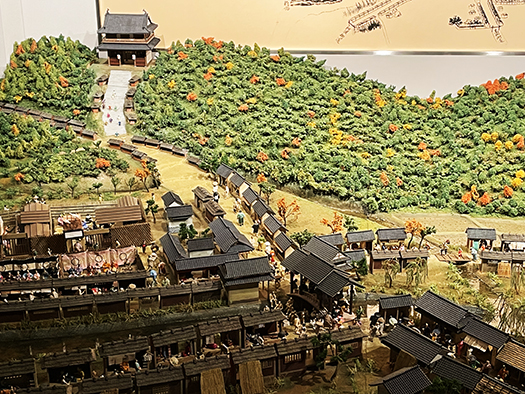
ここのところ「書く」仕事がメインになりつつあります。
きのう1日でも約10,000文字分は書いている。出版に関わって生きてきた人間として当然なのですが、現代人としては昔の作家たちのようにビジュアル要素までも文章で表現する、というような志向性はない。谷崎潤一郎など、その文章において美感表現を追求していると感じる。そしてその「書く環境」について妥協なく追究して、ほとんど「引っ越し魔」とでも言えるように自分の感受性を刺激してくれる空間を求め続けた。
たしかにかれの表現には、強い美への執着、視覚化という志向性を感じる。
しかし現代人というのは典型的に「マンガ」世代であり、テキスト表現で「絵画性」を求めるよりももっと直接的な画像表現、そのクリップ・ピンナップの感覚のほうがわかりやすい。
しかしビジュアルにもまた、わかりやすい表現とそうでないものが存在する。iPhoneの写真撮影でも瞬間的に「構図」とか、撮影意図に即した「直接力」があるかどうかが問われる。
とくにわたしは住宅雑誌という表現手段の世界で生きてきたので、その写真にもあらゆる意味合いを込めて撮影するというクセが根強くついている。そして当然ですが、あるテキストを書いていくとき、空間についてイメージを作って行くときには、写真の典型、自分が撮影した「ポイント」というようなものに集中していくことになる。一枚一枚の写真にはその「撮影意図」があって、そのことに常に「記憶再生」スイッチが入ってくる。
「そうだ、このときにはこういった意図が働いていた」ということが記憶再生されるのだ。
なので文章は、そういう空気環境のようなものと対応する表現として考えて行く。
たぶんその相関関係こそが、キモなのだと思っている。
まぁ写真雑誌をメインとして生きてきた人間の「性〜さが」でもあるのだろう。しかしやはりマンガ世代としては、表現は大きくこのようにメイン領域が変わったのだと思っている。
日本人は「鳥獣戯画」で宗教世界を表現するということにチャレンジした世界の中でも特異な民族。そしてその伝統、わかりやすくビジュアル化するということに長けているのではないか。
ということなんですが本日の写真は、金比羅さんのどこかで発見していた立体模型図。行ってみたあとで「あ、こんな風になっていたんだ」と追体験させてくれてわかりやすい一枚。
English version⬇
The publisher’s book “Writing” & Organizing Photographs
I continue to explore every day. I am able to concentrate on my field of interest, or rather, my life as it is. I feel like my head is going to explode from all the blood rushing through my veins.
The “writing” work is becoming my main focus these days.
Even in one day yesterday, I wrote about 10,000 words worth. As a person who has been involved in publishing for a long time, it is natural, but as a modern person, I do not have the same orientation as writers of the past, who expressed even visual elements in their writings. I feel that Tanizaki Junichiro, for example, pursues aesthetic expression in his writing. He pursued his “writing environment” uncompromisingly, almost as if he were a “mover and shaker,” continually seeking a space that would stimulate his sensibility.
It is true that in his expression, we can sense a strong attachment to beauty and an orientation toward visualization.
However, people today are typically of the “manga” generation, and rather than seeking “pictoriality” in textual expression, it is easier to understand the more direct expression of images and their clip-pinup sensibility.
However, there are some visual expressions that are easy to understand and others that are not, and even in iPhone photography, one is asked whether or not there is “composition” or “directness” that is in line with the intent of the shot.
Especially since I have lived in the world of housing magazines as a means of expression, I have a strong habit of putting all kinds of connotations into the photographs I take. And of course, when I write a text or create an image of a space, I concentrate on the typicality of the photograph, the “point” at which I took it. Each photograph has its own “photographic intent,” which always turns on the “memory reproduction” switch.
The “memory replay” switch is always turned on by the fact that each photograph has its own “photographic intention.
Therefore, I think of writing as an expression that corresponds to such an atmospheric environment.
Perhaps that correlation is the key.
Well, I guess that is the “nature” of those of us who have lived our lives mainly through photo magazines. However, as a member of the manga generation, I believe that the main domain of expression has changed dramatically in this way.
The Japanese are unique among the world’s peoples in that they have taken up the challenge of expressing the religious world in their “Birds, Animals, and Caricatures. I believe that the Japanese are skilled at visualizing their traditions in a way that is easy to understand.
So, today’s photo is a three-dimensional model drawing that I had found somewhere in Kompira-san. It is a piece that is easy to understand, making you relive the experience after you have been there and say, “Oh, I didn’t know it was like this.
Posted on 6月 17th, 2024 by 三木 奎吾
Filed under: 日本社会・文化研究







コメントを投稿
「※誹謗中傷や、悪意のある書き込み、営利目的などのコメントを防ぐために、投稿された全てのコメントは一時的に保留されますのでご了承ください。」
You must be logged in to post a comment.